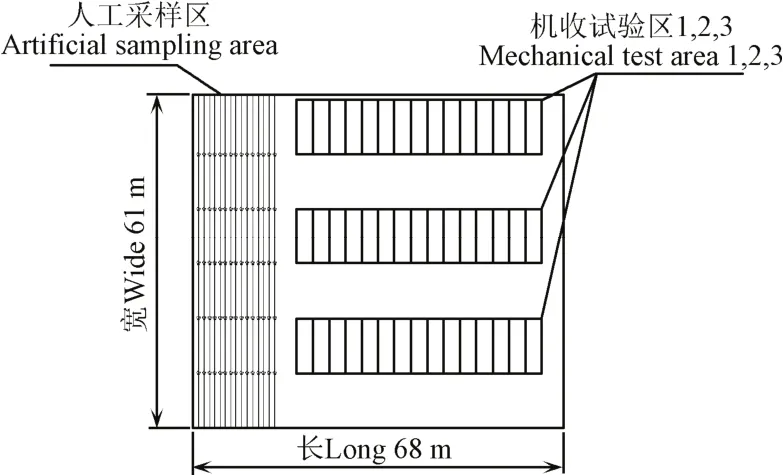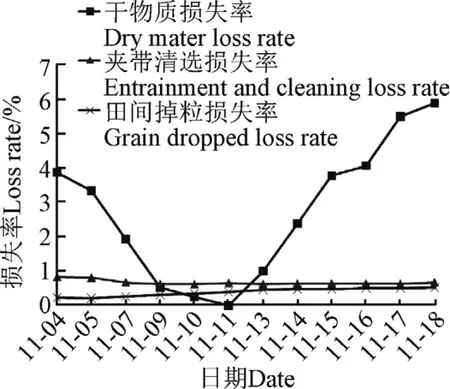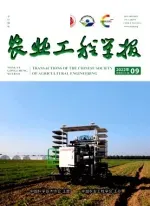收获时期对稻麦轮作水稻机收损失构成的影响
王桂民,易中懿,2※,陈 聪,曹光乔(. 江苏大学管理学院,镇江 22000;2. 江苏省农业科学院,南京 2004;. 农业部南京农业机械化研究所,南京 2004)
收获时期对稻麦轮作水稻机收损失构成的影响
王桂民1,易中懿1,2※,陈聪3,曹光乔3
(1. 江苏大学管理学院,镇江 212000;2. 江苏省农业科学院,南京 210014;3. 农业部南京农业机械化研究所,南京 210014)
摘要:为了研究稻麦轮作区水稻机械化收获损失构成特征及其不同收获时期的变化规律,该文在统一管理的同一水田,从全田90%的谷壳变黄开始至100%谷壳变黄止共12 d进行机收试验,测试水稻千粒质量、收割机夹带稻谷质量、割台碰撞掉粒数量、收获的稻谷质量等的变化情况。研究结果表明,水稻机收损失呈一元二次方程变化规律,越靠近11月11日的最佳收获日作业,损失率越低。计算得到稻麦轮作区水稻机收适时性损失系数为0.0009,相对损失率稳定在1%左右,绝对损失率在1.00%~6.80%之间变化。干物质损失是机收总损失的最主要来源,11月9日至13日平均总损失率为1.38%,平均干物质损失率为0.42%,占水稻机收总损失的30.43%;11月4日至18日,平均总损失率为3.61%,平均干物质损失率为2.61%,占水稻机收总损失的72.30%,最佳收获期应为11月9日至11月13日,即最佳收获日左右5 d。该研究可为稻麦轮作区水稻收获机械优化配置提供参考。
关键词:农作物;机械化;生长;水稻;适时性;损失;机具配备
王桂民,易中懿,陈聪,曹光乔. 收获时期对稻麦轮作水稻机收损失构成的影响[J]. 农业工程学报,2016,32(2):36-42.doi:10.11975/j.issn.1002-6819.2016.02.006http://www.tcsae.org
Wang Guimin, Yi Zhongyi, Chen Cong, Cao Guangqiao. Effect of harvesting date on loss component characteristics of rice mechanical harvested in rice and wheat rotation area[J]. Transactions of the Chinese Society of Agricultural Engineering (Transactions of the CSAE),2016, 32(2): 36-42. (in Chinese with English abstract)doi:10.11975/j.issn.1002-6819.2016.02.006http://www.tcsae.org
0 引 言
近年来中国水稻收获机械化快速发展,截至2013年,稻麦联合收割机总保有量113.43万台,水稻机收面积2 395.221万hm2,但其中跨区机收面积为769.569万hm2,同时中国仍有565.1万hm2水稻为人工收获,说明中国水稻机收服务仍处于供方市场[1],必然会延长收割期造成稻谷机收适时性损失[2],应该对中国与不同区域之间水稻收获装备结构进行优化配置,其中关键之处是确定水稻机收适时性损失系数与最优适收期。
水稻机收适时性损失包括稻谷干物质损失以及因机器作业产生的掉粒或夹带损失[3],其随稻谷成熟度(或不同收获日期)呈一元二次方程变化[4]。国外较早开始研究农作物适时性损失,尤其是美国已经拥有完备的主要农作物生产的适时性损失系数[5],并应用于农场经营效益分析[6]与理论研究。Whitson. R. E.等[7]基于不同区域适时性损失开展农机装备的选型。Sahu. R. K.等[8]利用农作物适时性损失理论开发了农机优化配备决策支持系统。国内现有关于水稻机收损失的文献大部分集中在将收获时间固定为相同时间,通过改变机器结构或运行参数测试损失率变化[9-14];在相同作业环境下研究不同机器损失率大小差异也是学界关注的热点之一[15-19],文献的关注重点是机器性能优劣而非水稻损失大小。部分学者通过人工取样测量不同收割期稻谷千粒质量的变化,从而得到干物质适时性损失,但忽略了机器作业本身导致的损失[20-22],研究结果准确性降低。为了准确获得稻麦轮作区水稻机收适时性损失,拟综合考虑因收获时期的变化导致谷粒干物质损失与机器作业形成的谷粒损失。
本文以稻麦轮作区粳稻为研究对象,从全田90%的谷壳变黄至100%谷壳变黄期间共12 d,在统一管理的同一水田采集稻谷千粒质量及机器收割的夹带与掉落稻谷质量,测得水稻干物质损失及机器夹带与割台损失之和随收获日期的变化规律,以期为农业机器优化配置及适收期的确定提供参考。
1 材料与方法
1.1适时性损失理论
水稻收成即稻谷收获量是水稻最高产量(预期产量)与收获损失量之间的差值,可由式(1)表示[2]。

式中Q为稻谷收获量,kg/hm2;Qm为水稻适时最高产量或预期产量,kg/hm2;ΔQ为稻谷收获损失量,kg/hm2。
水稻适时最高产量或预期产量是指按照农艺要求种植,排除因收割机、人工、自然等外部因素造成的损失,且在最佳收获日收获所得到的谷物质量。然而,收获期间无可避免会产生损失,如不在最佳收获日收获使谷粒没有达到最饱满状态而造成的损失,因收获机作业过程的碰撞而掉粒,谷物被秸秆夹带或未通过筛网而排出脱粒滚筒而造成损失等,掉粒损失与收割机排出的损失都是稻谷粒损失。总的来说,稻谷收获损失量可以分为干物质损失、稻谷粒损失,且随收获日期动态变化,可由式(2)、式(3)表示。通过试验可测定不同收获日期稻干物质损失量与稻谷粒损失量,获悉其变化规律,从而得到损失函数。

式中∆Q1为稻谷干物质损失,kg/hm2;∆Q2为夹带清选损失,kg/hm2;f1(t)为干物质损失与收获日期的函数;f2(t)为夹带清选损失与收获日期的函数。
1.2试验材料
本次试验时间为2014年11月4日至11月18日,11月4日时全田稻穗都下垂,超过90%的谷粒变黄,部分叶片开始发黄;11月18日时所有谷粒已经变黄,超过80%的叶片变黄。试验地点为南京市江宁区土桥公社稻麦香农业合作社,试验田为一块面积约为0.4 hm2水田,水田长度×宽度为68 m×61 m。测试水稻品种为武运粳23号,该田种植方式(30 cm行距,13 cm株距)、田间管理方式完全一致。测试工具为福田雷沃国际重工公司生产的谷神4LZ-4.0纵轴流全喂入联合收割机(喂入量4 kg/s,割幅为2 m),上海三久机械公司生产的三久TD-6水分仪(精度0.5%),上海上平仪器有限公司生产的上平JY20002电子天平(精度0.01 g)、50 m皮尺(精度0.01 m)、秒表(精度0.01 s)、筛子、彩条布、网兜、杆秤。
1.3试验方法
为方便收割机在田中行走,割出3片长45、宽10 m的机收试验区,试验区之间留有10 m的空地用于收割机掉头转弯。留下一片长61、宽15 m的人工采样区。在人工采样区沿稻田宽度方向,每隔10 m取1穴水稻,每天取5穴(详见图1),剪下所有稻穗,并数出每穴水稻的穗数及每穗谷粒数及结实谷粒数。将联合收割机的割台高度固定为30 cm,收割速度控制为1 m/s,在机收试验区1、2、3中分别划出15个长10 m、宽2 m的小区(如图1所示),每天在试验区1、2、3中各随机选择1个小区进行收割作业,即每天收割3个20 m2小区。

图1 样本田间分布Fig.1 Field distribution of sample
从收割机粮仓中取约0.5 kg稻谷,清理其中稻壳和秸秆,然后数取1 000粒结实稻谷,用电子天平测质量,用水分仪测稻谷含水率,重复3次。用网兜接取排草口排出的所有物料,将饱满谷粒从物料中分离出来,用电子天平称取质量,用水分仪测量水分。
在3个小区中各随机选定1个长2 m×0.5 m的无轮辙区域,用镰刀割掉区域内的割茬,拾取所有掉粒。可由下式计算得到千粒质量。其中11月6日、11月8日以及11月16日有小雨,中断试验并用彩条布遮盖试验区进行保护,形成局部无雨空间,不会因雨对试验造成影响。千粒质量、夹带清选损失、掉粒损失、相对损失率与绝对损失率的计算方法如下。

式中w为千粒质量均值,g;wi为千粒质量第i次测量值,g;di为稻谷含水量第i次测量值,%;Le为夹带清选损失,kg/hm2;Ld为掉粒损失,kg/hm2;Lej为第j个样本小区夹带质量,g;dej为第j个样本小区夹带物料含水率,%;Ndk为第k个掉粒区域内掉粒数量,粒;LR为相对损失率,%;LA为绝对损失率,%;wh为每日收获的稻谷质量,kg/hm2;wht为收割期内收获的稻谷质量单日最高值,kg/hm2。
2 结果与分析
通过12d的采样与测量得到样本田块水稻的穴数、单穴穗数、单穗谷粒数、结实率、结实谷粒数与千粒质量平均值如表1所示。
2.1水稻机收损失的变化规律
2.1.1谷粒损失动态
谷粒损失包括由联合收割机排杂口排出谷粒(夹带清选损失)以及因割台碰撞或自然掉落产生的掉粒(田间掉粒损失)。表2为不同收割期稻谷质量以及机收损失变化情况。由表2可知,夹带清选损失呈先减后增的变化趋势,损失量由11月4日的76.72下降到11月10日的57.11 kg/hm2,随后又开始缓慢增长至11月18日的62.41 kg/hm2。以最高预期产量作为基数,水稻机收的夹带清选损失率为0.59%~0.82%之间浮动。在12 d的收获期内,较高的夹带清选损失量主要集中在收获早期,水稻在未成熟前稻谷果柄活性高,抗拉强度高,脱粒难度大,结实谷粒脱离不完全随杂排出而产生损失。谷粒与秸秆含水率高,物料在脱粒滚筒的高速击打下产生大量自由水,谷粒与秸秆相互黏结,增加了筛选难度,难以充分筛净秸秆中的结实谷粒而形成损失。随着水稻成熟度提高,夹带清选损失量也逐渐减小。在收获中后期,夹带清选损失基本稳定并略有上升,因为水稻成熟后夹带损失不会有太大变化,但水分下降导致谷粒质量减轻,部分不完全饱满的谷粒被风机吹出排杂口而形成损失。

表1 样本水稻发育基本情况Table 1 Basic information of rice growing

表2 不同收割期稻谷质量以及机收损失变化情况Table 2 Rice weight and harvest loss in different duration
田间掉粒损失主要包括由收割机的拨禾轮与分禾器对水稻的摇晃造成谷粒或稻穗掉落田间,以及在风力吹动、飞鸟撞击、降雨击打等外力作用下产生谷粒或稻穗掉落田间形成的损失。田间掉粒损失呈线性增长趋势,损失量从11月4日的21.28增长至11月18日48.19 kg/hm2,以预期最高产量为基数,其损失率由0.23%升至0.53%。田间掉粒损失均与谷粒果柄与秸秆的连接强度相关,当水稻未成熟时,果柄连接强度高,需要较大的外力作用才能使谷粒掉落,所以田间掉粒损失小。随着水稻逐渐成熟,植株活性降低,果柄连接强度变低,谷粒掉落所需的外力较小,因此田间掉粒损失增大。
2.1.2干物质损失动态
收获的稻谷质量在收割期内呈先增后降的变化趋势,从11月4日的9 368逐日增长到11月11日的9 730 kg/hm2,随后逐渐降至11月18日的9 179 kg/hm2(表2)。主要原因是收获期间稻谷千粒质量发生变化,详见图2。

图2 稻谷千粒质量随收获期变化曲线Fig.2 Curve of 1 000 grain weight changing with harvest time
整个收获期,稻谷千粒质量有3个变化阶段。1)缓慢增长阶段,收获早期(11月4日-8日)由于水稻光合作用强于呼吸作用但差距在逐步减小,营养物质缓慢储存;2)质量最高峰,收获中期(11月9日-13日)光合作用与呼吸作用基本一致,生产与消耗的营养物质总量保持平衡,质量不再增加;3)缓慢减轻阶段,收获中晚期(11月14日-18日),光合作用持续减弱并低于呼吸作用,营养物质缓慢消耗。
11月11日的收获的稻谷质量最高,视其干物质损失为0。则其余收获期的干物质损失分布在0~551 kg/hm2,干物质损失率为0~5.66%。
2.1.3水稻机收损失函数
分别以干物质损失、夹带清选损失、田间掉粒损失为应变量,收割期为自变量作为回归得到不同的损失回归方程,汇总3个回归方程得到总损失方程,详见表3。

表3 收获期对水稻机收损失影响的回归方程Table 3 Regression equation of effect of harvesting date on rice mechanical harvest loss
水稻机收适时性损失函数为[21]。

式中RQ为机收适时性损失率;Qmax为水稻预期最高产量,kg/hm2。可得到水稻机收适时性损失函数

因此,样本水稻机收适时性损失系数为0.0009。水稻机收适时性损失呈一元二次方程变化规律,越靠近11 月11日的最佳收获日作业,水稻机收损失率越小,收割期越长,总损失越大。
2.2不同收获时期机收损失的构成比例
11月11日收获的稻谷质量为9 730 kg/hm2,达到收获期的最高产量,设定该产量为理论最高值,11月11日为最佳收获日。计算得到相对损失率(见表2)稳定在1%左右,绝对损失率(见表2)呈先降后增的变化趋势,变化区间为1.00%~6.80%,其中干物质损失率与绝对损失的变化趋势基本一致,夹带清选损失与田间掉粒损失的变化较小。图3为不同收获时期机收损失的构成比例。如图3所示,干物质损失占总损失的比例远高于夹带清选损失与田间掉粒损失,是总损失的最重要组成部分。

图3 不同收获时期机收损失的构成比例Fig.3 Composition of harvest loss on different date
干物质损失率的分布区间为0~5.88%,夹带清选损失率的分布区间为0.61%~0.82%,田间掉粒损失的分别区间为0.21%~0.51%。11月9日-11月13日,平均总损失率为1.38%,干物质平均损失率仅为0.42%,占总损失的30.43%;11月4日-11月18日,平均总损失率为3.61%,干物质的平均损失率为2.61%,占总损失的72.30%。因此,选择合适的收获时期,减少干物质损失,能有效减少水稻机收总损失。
2.3最佳收获期的确定
基于spss19.0中的单因素ANOVA模块最小显著差数法(least significant difference,简称LSD法)[23-24],分别以夹带清选损失、田间掉粒损失、收获的稻谷质量为因变量,以收割期为因子作单因素方差分析,结果如表4所示。

表4 不同收获期损失及收获质量的F值Table 4 F-value on lost and yield of different date
不同收获期的夹带清选损失在0.05显著性水平下具有显著差异,田间掉粒损失与收获的质量在0.01显著性水平下具有显著差异。由不同收获期损失及收获质量的F值可知,收获时期对收获稻谷质量的影响>田间掉粒损失>夹带清选损失。对收获稻谷质量均值差的LSD进行多重比较检验,部分数据如表5所示。

表5 收获稻谷质量均值差的LSD多重比较Table 5 LSD multiple comparison of average rice weight
由收获稻谷质量均值差的LSD多重比较值可知,11 月4日、5日、15日、16日收获的稻谷质量在0.05水平下无显著差异;11月9日、10日、11日、13日收获的稻谷质量在0.05水平下无显著差异,4 d的均值差均小于50 kg/hm2;11月17日、18日收获的稻谷质量在0.05水平下无显著差异。11月9日-13日为连续时间段,期间收获的稻谷质量最高,损失率最低,故11月9日-13日为最佳适收期,即最佳收获日(11月11日)5 d左右。
3 讨 论
中国稻麦轮作区水稻机收适时性损失系数为0.0009,笔者未检索到稻麦轮作区水稻收获适时性研究的相关其他文献,无法进行区域内的对比。东北农业大学研究得到黑龙江单季稻干物质适时性损失系数为的0.004[21],高于本文的稻麦轮作区研究结果,说明东北地区水稻机收适时性损失受收获时期的影响较大。主要由于东北地区水稻收获期的昼夜温差大,不同日期气温变化大,水稻干物质的积累与消耗速率也较快。
11月9日-11月13日水稻收获平均总损失率为1.38%,干物质平均损失率仅为0.42%,占总损失的30.43%,所有指标都远低于11月4日-11月18日,该时间段即为最佳收获期。王福林等[20]、李振卿[2]均认为适时性损失最低的阶段即为最佳适收期,与本文研究结果一致。在关于粮食收获损失的研究中,现有文献多不考虑干物质[9-10,16-17]随收获日期产生的变化,得到的损失值显著偏低,本文测得的干物质损失占总损失70.30%,是水稻机收损失的最主要来源,忽略该主要组成部分,研究结论对农业生产的指导作用必然下降。而王金武[21]得到的东北稻区收获适时性损失仅包含干物质损失,但缺因机器作业产生的谷粒损失,其结果也具有一定的局限性。本文得到的因机器作业产生的谷粒损失虽然占总损失较小,但受收获时期的影响是显著的。笔者认为,水稻损失应同时考虑机器作业形成的谷粒损失与干物质损失,而且两者都随收获时期动态变化,干物质损失的变化更显著。因此在确定适收期时,应以尽量减小干物质损失为目标。
4 结 论
本文基于水稻收获损失随成熟度变化的特点,通过12 d跟踪测试全喂入联合收割机收割武运粳23号,测得了不同收割期夹带清选损失、田间掉粒损失、干物质损失、收获的稻谷质量、稻谷千粒质量等变化,计算得到相对损失率与绝对损失率,相对损失率稳定在1%左右,绝对损失率在1.00%~6.80%之间变化。
通过综合稻谷干物质损失、夹带清选损失、田间掉粒损失,得到武运粳23号机收的适时性损失函数为一元二次方程,适时性损失系数为0.0009。结果表明,越靠近11月11日的最佳收获日作业,水稻机收损失率越小,收割期越长,损失率将显著增加;干物质损失是机收适时性损失主要来源。11月9日-13日,平均总损失率为1.38%,平均干物质损失率为0.42%,占水稻机收总损失的30.43%;11月4日-18日,平均总损失率为3.61%,平均干物质损失率为2.61%,占水稻机收总损失的72.30%,最佳收获期为11月9日-11月13日,即最佳收获日左右5 d。该研究为某一区域或规模经营主体的收割机优化配备提供了参考。
[参考文献]
[1] 李伟毅,赵佳,胡仕华. 小农条件下农业现代化的实现途径-农机跨区作业的实践与其实践[J]. 中国农机化,2010(2):10-15. Li Weiyi, Zhao Jia, Hu Shihua. The path to agricultural modernization under smallholders condition -Practice and enlightenments of trans-regional work of agricultural machinery[J]. Chinese Agricultural Mechanization, 2010(2): 10-15. (in Chinese with English abstract)
[2] 李振卿. 作业的适时性函数及作业期较佳分布的确定[J].农业机械学报,1986,13(4):69-77. Li Zhenqing. Function of operation’s timeliness and determination of proper distribution of operations’ duration[J]. Transactions of the Chinese Society for Agricultural Machinery, 1986,13(4): 69-77. (in Chinese with English abstract)
[3] 李振卿. 作业适时性损失灼分析与计算及作业的适时性优化(一)[J]. 东北农学院学报,1985(3):74-80. Li Zhenqing. Analysis, calculation and optimization of field operation’s timeliness loss(1)[J]. Journal of Northeast Agricultural College, 1985(3): 74-80. (in Chinese with English abstract)
[4] 李振卿. 作业适时性损失灼分析与计算及作业的适时性优化(二)[J]. 东北农学院学报,1985(4):102-112. Li Zhenqing. Analysis calculation and optimization of field operation’s timeliness loss(2)[J]. Journal of Northeast Agricultural College, 1985(4): 102-112. (in Chinese with English abstract)
[5] Toro A D. Influences on timeliness costs and their variability on arable farms[J]. Biosystems Engineering, 2005, 92(1): 1-13.
[6] Tulu M Y, Holtman J B, Fridley R B, et al. Timeliness costs and available working days—shelled corn[J]. Transactions of the ASAE, 1974, 17(10): 798-800, 804.
[7] Whitson R E, Kay R D, Lepori W A, et al. Machinery and crop selection with weather risk[J]. Transactions of the ASAE, 1981, 24(2): 288-291, 295
[8] Sahu R K, Raheman H. A decision support system on matching and field performance prediction of tractor-implement system[J]. Computers and Electronics in Agriculture, 2008, 60(1): 76-86.
[9] 张军,王兴龙,石广跃,等. 不同机栽方式下杂交稻产量及其形成特征比较[J]. 农业工程学报,2015,31(10):84-91. Zhang Jun, Wang Xinglong, Shi Guangyue, et al. Yield and its formation of hybrid rice under different mechanical transplanted methods[J]. Transactions of the Chinese Society of Agricultural Engineering (Transactions of the CSAE),2015, 31(10): 84-91. (in Chinese with English abstract)
[10] 寇丹,苏德荣,吴迪,等. 地下调亏滴灌对紫花苜蓿耗水、产量和品质的影响[J]. 农业工程学报,2014,30(2):116-123. Kou Dan, Su Derong, Wu Di, et al. Effects of regulated deficit irrigation on water consumption, hay yield and quality of alfalfa under subsurface drip irrigation[J]. Transactions of the Chinese Society of Agricultural Engineering (Transactions of the CSAE), 2014, 30(2): 116-123. (in Chinese with English abstract)
[11] 魏宏安,张俊莲,杨小平,等. 4UFD-1400型马铃薯联合收获机改进设计与试验[J]. 农业工程学报,2014,30(3):12-17. Wei Hongan, Zhang Junlian, Yang Xiaoping, et al. Improved design and test of 4UFD-1400 type potato combine harvester[J]. Transactions of the Chinese Society of Agricultural Engineering (Transactions of the CSAE), 2014,30(3): 12-17. (in Chinese with English abstract)
[12] 程绍明,王俊,卢志乐,等. 小型整秆式甘蔗收割机改进设计与试验[J]. 农业工程学报,2014,30(4):12-17. Cheng Shaoming, Wang Jun, Lu Zhile, et al. Revised design and experiment on small-sized whole-stalk sugarcane harvester[J]. Transactions of the Chinese Society of Agricultural Engineering (Transactions of the CSAE), 2014,30(4): 12-17. (in Chinese with English abstract)
[13] 宋云生,张洪程,戴其根,等. 水稻机栽钵苗单穴苗数对分蘖成穗及产量的影响[J]. 农业工程学报,2014,30(10):37-47. Song Yunsheng, Zhang Hongcheng, Dai Qigen, et al. Effect of rice potted-seedlings per hole by mechanical transplanting on tillers emergence, panicles formation and yield[J]. Transactions of the Chinese Society of Agricultural Engineering (Transactions of the CSAE), 2014, 30(10): 37-47. (in Chinese with English abstract)
[14] 钱银飞,张洪程,吴文革,等. 机插穴苗数对不同穗型粳稻品种产量及品质的影响[J]. 作物学报,2009,35(9):1689-1707. Qian Yinfei, Zhang Hongcheng, Wu Wen′ge, et al. Effects of seedlings number per hill on grain yield andquality in different panicle types of mechanical transplanted japonica rice[J]. Acta Agronomica Sinica, 2009, 35(9): 1689-1707. (in Chinese with English abstract)
[15] 许轲,张军,张洪程,等. 双季晚粳稻不同栽培方式生产力及其群体质量差异研究[J]. 中国水稻科学,2014,28(5):503-513. Xu Ke, Zhang Jun, Zhang Hongcheng, et al. Difference in grain productivity and population quality of double-cropping late japonica rice under different cultivation methods[J]. Chinese Journal of Rice Science, 2014, 28(5): 503-513. (in Chinese with English abstract)
[16] 许轲,唐磊,张洪程,等. 不同机械直播方式对水稻分蘖特性及产量的影响[J]. 农业工程学报,2014,30(13):43-52. Xu Ke, Tang Lei, Zhang Hongcheng, et al. Effect of different mechanical direct seeding methods on tiller characteristics and yield of rice[J]. Transactions of the Chinese Society of Agricultural Engineering (Transactions of the CSAE), 2014,30(13): 43-52. (in Chinese with English abstract)
[17] 梁启新,韦剑锋,苏世明,等.施氮量和移栽密度对晚稻甬优6茎蘖生长和产量的影响[J]. 广东农业科学,2012(19):57-60. Liang Qixin, Wei Jianfeng, Su Shiming, et al. Effects of applied nitrogen rate and transplanting density on stems and tillers growth and yield in late rice Yongyou6[J]. Journal of Guangdong Agricultural Sciences, 2012(19): 57-60. (in Chinese with English abstract)
[18] 唐忠,李耀明,赵湛,等. 切纵流联合收获机小麦夹带损失检测试验与分析[J]. 农业工程学报,2012,28(1):11-16. Tang Zhong, Li Yaoming, Zhao Zhan, et al. Test and analysis of wheat entrainment loss for tangential-longitudinal-axial combine harvester[J]. Transactions of the Chinese Society of Agricultural Engineering(Transactions of the CSAE), 2012,28(1): 11-16. (in Chinese with English abstract)
[19] 刘德军,赵秀荣,高连兴,等. 不同收获方式含水率对油菜收获物流损失的影响[J]. 农业工程学报,2011,27(10):339-342. Liu Dejun, Zhao Xiurong, Gao Lianxing, et al. Effect of moisture content on rape harvest logistics losses under different harvest methods[J]. Transactions of the Chinese Society of Agricultural Engineering (Transactions of the CSAE), 2011, 27(10): 339-342. (in Chinese with English abstract)
[20] 王福林,董国荣,周文其. 作业期最佳分布定理及其证明方法[J]. 农业机械学报,1997,28(11):102-105. Wang Fulin, Dong Guorong, Zhou Wenqi. Research on the theorem for the optimized distribution of the operation’s term[J]. Transactions of the Chinese Society for Agricultural Machinery, 1997, 28(11): 102-105. (in Chinese with English abstract)
[21] 王金武. 三江平原地区水稻收获期适时性损失的研究[J].农业机械学报,2004,35(2):175-177. Wang Jinwu. Research of the rice harvesting season timeliness loss in Sanjiang plain zone[J]. Transactions of the Chinese Society for Agricultural Machinery, 2004, 35(2): 175-177. (in Chinese with English abstract)
[22] 王金武,杨广林. 三江平原水稻插秧适时性研究[J]. 东北农业大学学报,2008,35(4):472-475. Wang Jinwu, Yang Guanglin. Research of the rice planting season timeliness loss in Sanjiang plain zone[J]. Journal of Northeast Agricultural University, 2008, 35(4): 472-475. (in Chinese with English abstract)
[23] 孙建军,张洪程,王生轩,等. 播期对不同品种类型机插稻生长特性的影响[J]. 农业工程学报,2015,31(21):76-86. Sun Jianjun, Zhang Hongcheng, Wang Shengxuan, et al. Effects of seeding date on growth characteristics of mechanical transplanted rice of different variety types[J]. Transactions of the Chinese Society of Agricultural Engineering (Transactions of the CSAE), 2015, 31(21): 76-86. (in Chinese with English abstract)
[24] 邢志鹏,曹伟伟,钱海军,等. 播期对机插水稻产量构成特征的影响[J]. 农业工程学报,2015,31(13):22-31. Xing Zhipeng, Cao Weiwei, Qian Haijun, et al. Effect of sowing date on yield component characteristics of mechanically transplanted rice[J]. Transactions of the Chinese Society of Agricultural Engineering (Transactions of the CSAE), 2015, 31(13): 22-31. (in Chinese with English abstract)
Effect of harvesting date on loss component characteristics of rice mechanical harvested in rice and wheat rotation area
Wang Guimin1, Yi Zhongyi1,2※, Chen Cong3, Cao Guangqiao3
(1. School of Mɑnɑgement, Jiɑngsu University, Zhenjiɑng 212000, Chinɑ;
2. Jiɑngsu Acɑdemy of Agriculture Science, Nɑnjing 210014, Chinɑ;
3. Nɑnjing Reseɑrch Institute for Agriculturɑl Mechɑnizɑtion, Ministry of Agriculture, Nɑnjing 210014, Chinɑ)
Abstract:Rice harvesting mechanization in China is developing rapidly in recent years. In 2013, the total of rice and wheat combine harvester was 1.13 million, the mechanical rice harvesting area was 23.95 million hm2, of which the area cross the district was 7.70 million hm2, and at the same time, there was an area of 5.65 million hm2harvested by manpower. Nowadays,the machine harvesting service of rice in China has been still in a supplier market, which results in the situation of making farmers wait for machines and thus prolongs the harvest time and causes a loss to the machine harvesting. However there are few researches on the loss from the machine harvest of rice and the elements of grain loss in the current studies. In this paper,the author sets a mechanical harvesting test in a paddy field with unified management during 12 consecutive days, which is to test the weight of 1 000 grains of rice, the weight of grain remained inside the harvester, the weight of grain dropped from the hit by cutting table and the weight of harvested rice, and then calculate the relative loss rate and absolute loss rate according to the data. The results show that the distribution range of the loss rate of dry matter is 0-5.88%, that of the entrainment cleaning loss rate is 0.61%-0.82%, and that of the loss rate of grain in the field is 0.21%-0.51%. The entrainment cleaning loss on different harvesting date has a significant difference at 0.05 significant level, and the loss of grain in the field and the weight of harvested rice have significant difference at 0.01 significance level. It can be seen from the F-value that the impacts of harvesting date on different factors are as follows: the weight of rice harvested > grain dropped loss in the field > entrainment and cleaning loss. On November 4th, 5th, 15thand 16th, there was no significant difference for the weight of harvested rice; on November 9th, 10th, 11thand 13th, there was no significant difference for the weight of harvested rice; on November 17thand 18th, there was also no significant difference for the weight of rice harvested. On November 9th-13th, the weight of harvested rice was the highest, and the loss rate was the lowest. The timeliness loss of rice mechanical harvesting is a quadratic curve; the longer the harvesting period, the more obvious the loss rate. The coefficient of timeliness loss of rice mechanical harvesting is 0.0009. About 5 days earlier or later from the optimal harvest date, the average loss rate of rice mechanical harvesting is 1.38%, which accounts for 30.43% of the total loss, and the average loss rate of dry matter is 0.42%; about 15 days earlier or later from the optimal harvest date, the average loss rate of rice mechanical harvesting is 3.61%, which accounts for 72.30% of the total loss, and the average loss rate of dry matter is 2.61%. In a conclusion, the optimal harvesting day is from November 9thto 13th. This research can be helpful to determine the optimal harvesting period, and produce the dynamical parameters to provide the data support for harvester allocation optimization that is aimed at the best production efficiency.
Keywords:crops; mechanization; growth; rice; timeliness; loss; agricultural machinery equipment
通信作者:※易中懿,男,安徽金寨人,博士生导师,教授,研究方向为农业机械化与农村发展。镇江江苏大学管理学院,212000。Email:yzy201@163.com
作者简介:王桂民,男,山东诸城人,博士生,高级工程师,研究方向为农业机械化。镇江江苏大学管理学院,212000。Email:47149031@qq.com
基金项目:中国农业科学院科技创新工程(农科院办(2014)216号);国家科技支撑计划课题(2013BAD08B01-5)。
收稿日期:2015-06-03
修订日期:2015-12-21
中图分类号:S233.4
文献标志码:A
文章编号:1002-6819(2016)-02-0036-07
doi:10.11975/j.issn.1002-6819.2016.02.006

